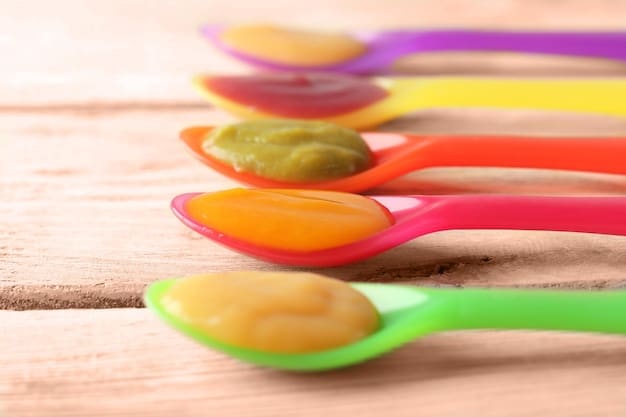Baby’s First Foods: Pediatrician’s Timeline for 2025 (US)

Introducing solid foods to babies involves following a pediatrician-recommended timeline, typically starting around 6 months with iron-rich purees such as fortified cereals and progressing to a variety of fruits, vegetables, and proteins as they mature, while closely observing for any allergic reactions.
Navigating the world of baby’s first foods: a pediatrician’s recommended timeline for 2025 can feel overwhelming for new parents. When should you start introducing solids? What foods are best to begin with? This guide offers a clear, pediatrician-backed timeline to help you confidently embark on this exciting milestone.
Understanding the Readiness Signs for Starting Solids
Before diving into a specific timeline, it’s crucial to recognize the signs that your baby is ready for solid foods. These signs indicate that their digestive system has matured enough to handle foods beyond breast milk or formula.
Starting solids too early can lead to digestive issues and potential allergies, while waiting too long can hinder nutrient intake and oral-motor development.
Key Readiness Indicators
Here are some essential indicators that suggest your baby is ready to start their solid food journey:
- Age: Typically around 6 months old.
- Head and Neck Control: The ability to sit upright with good head control.
- Loss of Tongue-Thrust Reflex: No longer automatically pushing food out of their mouth.
- Interest in Food: Showing curiosity and reaching for food others are eating.
- Ability to Swallow: Moving food from the front to the back of the mouth and swallowing effectively.
Remember, every baby develops at their own pace. If you’re unsure, consult with your pediatrician for personalized guidance.
Identifying these readiness signs is a critical first step in ensuring a smooth and enjoyable transition to solid foods for your baby.
The Pediatrician-Recommended Timeline: Month-by-Month Guide
Once you’ve confirmed that your baby is showing signs of readiness, you can begin introducing solids following a gradual and age-appropriate timeline. This timeline is designed to minimize the risk of allergies and digestive upset while providing essential nutrients.
This timeline is a general guideline and should be adapted to your baby’s individual needs and preferences, always in consultation with your pediatrician.
6 Months: Single-Ingredient Purees
Start with simple, single-ingredient purees that are easy to digest. Iron-fortified cereal mixed with breast milk or formula is often recommended as a first food. Other good options include:
- Sweet Potato: A naturally sweet and nutritious choice.
- Avocado: Provides healthy fats and a creamy texture.
- Butternut Squash: Mild flavor and rich in vitamins.
Introduce one new food every 3-5 days to monitor for any allergic reactions. Signs of an allergic reaction can include rash, hives, vomiting, or diarrhea. If you notice any of these symptoms, stop feeding that food and consult your pediatrician.
During this phase, focus on offering small amounts and letting your baby explore the textures and flavors. It’s more about introducing the concept of solid food rather than providing a significant source of nutrition at this stage.

7-8 Months: Expanding Flavors and Textures
As your baby gets more comfortable with purees, you can start introducing a wider variety of fruits, vegetables, and proteins. This is also a good time to gradually increase the texture of the foods.
This period is crucial for expanding your baby’s palate and introducing them to a diverse range of nutrients.
New Foods to Try
Consider these options for expanding your baby’s diet:
- Fruits: Applesauce, bananas, pears, peaches.
- Vegetables: Green beans, carrots, peas.
- Proteins: Pureed chicken, beef, lentils, tofu.
Offer foods in slightly thicker textures, such as mashed or finely chopped. You can also start introducing soft finger foods like cooked sweet potato sticks or avocado slices.
Continue to introduce one new food every few days and monitor for any allergic reactions. As your baby gets more experienced, you can start combining different foods to create more complex flavors.
Expanding flavors and textures at this stage is essential for developing healthy eating habits and ensuring your baby receives a wide range of nutrients.
9-12 Months: Introducing Finger Foods and Family Meals
Around 9-12 months, your baby should be able to handle a wider variety of textures and flavors. This is an excellent time to introduce more finger foods and involve them in family meals (modified for their age and abilities, of course!).
Introducing finger foods and family meals can help develop their independence and socialization around food.
Encouraging Self-Feeding
Here are some tips for encouraging self-feeding:
- Offer a Variety of Finger Foods: Soft cooked vegetables, small pieces of fruit, pasta, and cheese.
- Cut Foods into Small, Manageable Pieces: Reduce the risk of choking.
- Allow Exploration: Let your baby explore the textures and flavors with their hands.
- Be Patient: Self-feeding can be messy, but it’s an important skill to develop.
Continue to offer a variety of foods from all food groups. You can also start introducing more complex flavors and spices, but avoid adding salt or sugar.
Introducing finger foods and adapted family meals at this stage promotes independence, fine motor skill development, and a sense of belonging during mealtimes.

Addressing Common Concerns and Challenges
Introducing solid foods can come with its own set of challenges. Understanding common concerns and knowing how to address them can help make the process smoother for both you and your baby.
Knowing how to manage common challenges ensures a positive and nutrient-rich experience for your baby’s dietary journey.
Common Issues and Solutions
- Picky Eating: Continue to offer a variety of foods, even if your baby initially refuses them. It can take multiple exposures for a baby to accept a new food.
- Allergic Reactions: Introduce one new food at a time and monitor for any symptoms. Keep a food diary to track what your baby eats and any reactions they may have.
- Constipation: Ensure your baby is getting enough fiber from fruits, vegetables, and whole grains. Offer water or diluted fruit juice to help soften stools.
Remember to consult your pediatrician if you have any concerns about your baby’s eating habits or health.
Addressing these challenges with patience and informed strategies will help ensure your baby develops a positive relationship with food.
Foods to Avoid in the First Year
While introducing solid foods, it’s essential to be aware of certain foods that should be avoided in the first year of life due to safety and health concerns.
Understanding what to avoid is crucial for preventing allergies, choking hazards, and other health issues during your baby’s first year.
Foods to Exclude
- Honey: Can contain botulism spores that are dangerous for infants.
- Cow’s Milk: Not easily digested and can interfere with iron absorption.
- Grapes, Hot Dogs, and Hard Candy: Choking hazards.
- Salty or Sugary Foods: Can promote unhealthy eating habits and may harm developing kidneys.
Always prioritize your baby’s safety when selecting foods. Cut foods into small, manageable pieces and supervise them closely during mealtimes.
By avoiding these foods, parents can minimize risks and foster a healthier start to their baby’s eating habits.
Monitoring Your Baby’s Progress and Adjusting the Timeline
Throughout the process of introducing solid foods, it’s important to carefully monitor your baby’s progress and adjust the timeline as needed. Each baby is unique, and their individual needs and preferences should guide your approach.
Regular monitoring and flexibility ensure that your baby’s unique needs are met during this important period of development.
Tips for Ongoing Assessment
Keep these tips in mind as you navigate your baby’s food journey:
- Observe for Allergic Reactions: Continue to introduce new foods one at a time and watch for any signs of allergies.
- Adjust Textures: As your baby’s chewing skills improve, gradually increase the texture of the foods.
- Pay Attention to Preferences: Offer a variety of foods and note what your baby enjoys and dislikes.
- Consult Your Pediatrician: Seek guidance from your pediatrician if you have any concerns about your baby’s growth or development.
Flexibility and attentiveness are key to a successful transition to solid foods. Celebrate small victories and be patient with setbacks.
By closely monitoring your baby’s development and adapting the timeline accordingly, you can provide the best possible start to their lifelong journey with food.
| Key Point | Brief Description |
|---|---|
| 👶 Readiness Signs | Look for signs like head control and interest in food around 6 months. |
| 🍎 First Foods | Start with single-ingredient purees like sweet potato or avocado. |
| 🥄 Textures | Gradually increase textures from purees to mashed and soft finger foods. |
| 🚫 Foods to Avoid | Avoid honey, cow’s milk, grapes, and highly processed foods. |
Frequently Asked Questions
▼
Most pediatricians recommend starting solid foods around 6 months of age, but always look for readiness signs like good head control and interest in food.
▼
Iron-fortified cereal is a common first food. Other good options include pureed sweet potato, avocado, and butternut squash, introduced one at a time.
▼
Introduce new foods one at a time, waiting 3-5 days between each. Watch for rash, hives, vomiting, or diarrhea, and consult your pediatrician if these occur.
▼
Begin with smooth, single-ingredient purees. Gradually move to mashed, finely chopped, and then soft finger foods as your baby becomes more experienced.
▼
Yes, avoid honey, cow’s milk, grapes, hot dogs, and excessively salty or sugary foods to prevent botulism, allergies, choking hazards, and unhealthy habits.
Conclusion
Introducing baby’s first foods: a pediatrician’s recommended timeline for 2025 is a significant milestone. By following a pediatrician-approved timeline, carefully monitoring for readiness signs and potential allergic reactions, and introducing a variety of flavors and textures gradually, you can set your baby up for a lifetime of healthy eating habits. Remember to always consult your pediatrician for personalized advice and support throughout this exciting journey.





